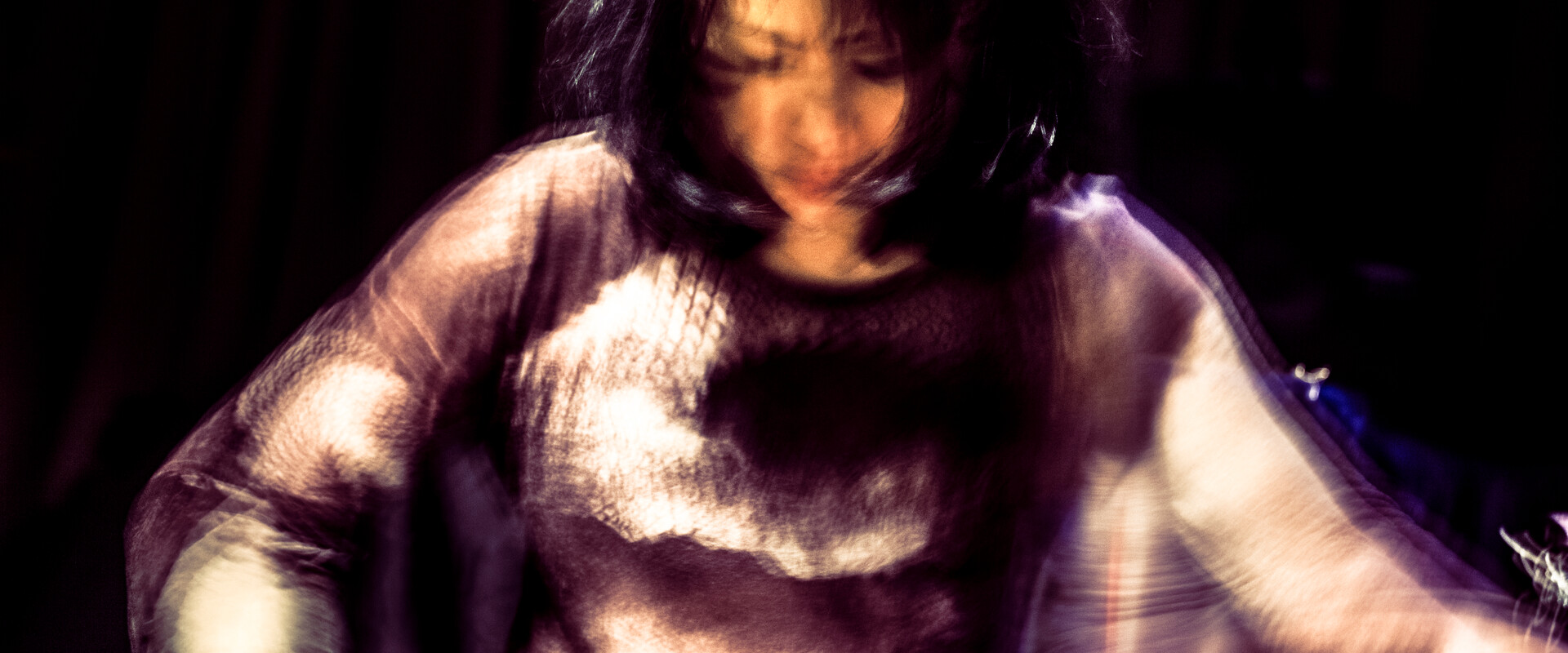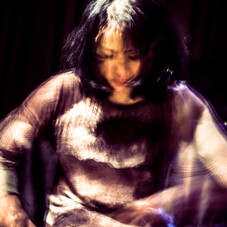I never chose the koto. The koto chose me. My mother was a koto teacher so I grew up with the instrument.
The koto is a Japanese stringed instrument that is often called a type of zither, but in terms of how it’s played it might be better described as a transverse harp. The traditional koto had 13-strings made of silk, moveable bridges made of ivory, and was played with three fingerpicks made of deerskin and ivory. In the modern age some of these materials were deemed “politically incorrect” or too costly to maintain and have largely been replaced with synthetic materials such as plastic and nylon. Traditional koto music is basically monophonic, played with the fingerpicks on the middle and index fingers and thumb of the right hand, with the left hand mostly used for bending the strings. Unlike a guitar or piano, the bridges need to be pre-adjusted to the scale of the composition, which is both an advantage in terms of playing unusual scales or microtones, and a disadvantage in terms of playing chord changes.
I play two kinds of modern kotos that were conceived during the 20th century — the 21-string koto, which considerably broadened the range of the traditional koto, and the 17-string koto, sometimes called the bass koto although its range is closer to the cello. Both of my kotos have been modified for amplification and can be plugged directly into an amp or PA system. I also use various electronic effects such as distortion, looping, delay, and ring modulation. I also incorporate various extended playing techniques. Drumsticks, a contrabass bow, a metal bar for slide playing, a mini cymbal, and several other odds and ends are part of my usual equipment. I like to call my entire setup “hyper koto.” My own music is more harmonic than traditional koto playing because I use both hands to pluck the strings and play chords. But I like to think that my instruments, my vocal style, and the music I write are all extensions of traditional Japanese music.
I would never call myself a jazz musician, but because I’ve long been involved in improvised music, I have had the good fortune to be able to work with many fine jazz musicians as well as some of the world’s most prominent improvisers.
From a very young age I liked to “play around” on the koto, spontaneously making up songs and melodies whenever I wasn’t practicing the traditional repertoire as taught by my mother. I eventually got tired of the koto and switched to piano. I returned to the koto after hearing a contemporary piece for bass koto on the radio when I was in my late teens, and became apprenticed for several years to Tadao Sawai, one of the most prominent postwar koto players and composers, and his wife Kazue Sawai. On one occasion they had me attend an improv workshop where I realized that I had a natural flair for improvisation. When the Sawai school sent me to teach Japanese music at Wesleyan University in the United States for a year, I was first exposed to the music of John Cage, Christian Wolff and other contemporary composers, and that led to meetings with New York-based composer-improvisers such as John Zorn and Elliott Sharp. I began premiering new pieces for koto, and was also invited to some improv gigs.
Not long after I returned to Japan I decided I wanted to play my own music. By the time John Zorn asked me to record for his Tzadik label in the late 1990’s, I was freelancing in Tokyo as a performer and improviser and beginning to compose my own material. In the first decade of the 2000’s, my circle of musical partners grew dramatically both domestically and abroad. I had the good fortune to meet and work with many incredible Norwegian musicians such as Paal Nilssen-Love, Ingebrigt Háker Flaten, Eivind Aarset, and Bugge Wesseltoft. I worked extensively with the late Peter Brötzman, who became one of my most important mentors. And I began a longstanding collaboration with one of Japan’s top jazz drummers, Tamaya Honda, with whom I formed Dōjō, probably the world’s first improvising koto-drums power duo. That pretty much brings us to today, I think.
That’s interesting you should ask me that. At certain times in history the koto as well as some of its other Asian relatives have been instruments of personal solace. For example, in Japan during the middle ages, the koto was mostly enjoyed in private by women of the upper classes. I think an aspect of that remains to this day.
In my case, things have changed a bit since I was young, and playing alone usually means composing or practicing rather than just having fun. As for whether I prefer small or big crowds to perform for, I’d have to say there’s no difference to me. Whether I’m playing for three people or three thousand, I feel like I’ve invited the audience into my own living room. For me, performance is always up close and personal.
I play solo gigs; Dōjō gigs, sometimes with a guest joining me and Tamaya, that are usually entirely improvised; and trio gigs with Tamaya and bassist Takashi Sugawa that mostly feature my own original compositions. I lead a multi-koto ensemble named Talon for which I mostly write originals, but we also play arrangements of traditional Japanese material as well as some oddball covers (e.g. the theme to the 60’s TV series “Captain Ultra,” composed by Isao Tomita).
I used to lead a group called the Michiyo Yagi Double Trio, with two drummers and two bassists (one doubling on cello), that I hope to resurrect someday (we were a bit of a hit at the Moers Festival in 2011).
As for recordings, I have a new album coming out soon on Jazzland Recordings that was co-produced by Eivind Aarset, and also several Dōjō sessions featuring some exciting guests. There are some unreleased performances with Peter Brötzmann that will hopefully see the light of day. And I’m eager to get Talon into the studio.
I really can’t choose any of the three gigs I’m playing in Saalfelden over the others. Tamaya and I toured with Ingebrigt Håker Flaten several years ago and it was a blast every night. Eivind Aarset is Tamaya’s favorite guitarist as well as mine, so we’re very excited about playing with him again. As for my duo with Hamid Drake, we first played together last November in Poland after promising to do so nearly 20 years ago. I must admit it ended up being one of my favorite performances of all time, so let’s hope we can top it this year.
I can’t imagine doing anything else. Without a career in music, I might have become…maybe a raging homemaker? (LOL)
I played in Vienna many years ago with the Kazue Sawai Koto Ensemble. And I’ve played at the Unlimited Festival in Wels twice, both times with Peter Brötzmann.
Let me add that I am truly honored to be named one of Jazzfestival Saalfelden’s “Artists in Residence” this year. I promise to give the audience my 100%. And I hope Peter will be watching over me.



